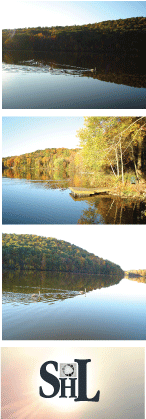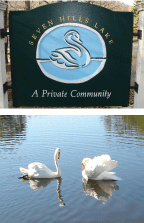THE TECHNICAL STUFF ABOUT OUR LAKE:
Current Lake Documents (as of October, 2022):
Fish Species
Water Quality Graphs
Aquatic Plant Survey
Sediment Report
Watershed Nutrient Sampling
Watershed Survey
To review previous lake documents please click here.
One of the natural forces we find ourselves battling is eutrophication. Eutrophication is a process where lakes receive excess nutrients that stimulate excessive plant growth such as algae and periphyton attached algae. This enhanced plant growth, often called an algal bloom, reduces dissolved oxygen in the water when dead plant material decomposes, becomes toxic and can cause other organisms to die. It would help if we all made a concerted effort to prevent the nutrients we can control from washing into the lake. Nutrients in the lake can come from many sources, such as fertilizers applied to gardens, or lawns; nitrogen from the atmosphere; erosion of soil; discharges or run-off from leaking septic systems; and even outdoor pet and wild animal excrement. For the education of those interested in exploring this subject further, we have a number of technical papers available for you to read here: TechnicalPapers. Since our area depends on well water, any discussion of eutrophication would not be complete without acknowledging the concerns we all share with respect to untreated Stormwater. There is a discussion of this issue at this link and there are several brand new two-minute videos on the subject of Stormwater from the Town of Kent posted there (keep scrolling) as well. In addition to our eutrophication concerns, our lake also fosters the growth of highly invasive Milfoil and Pondweed and you can click on the links provided to read more about their characteristics. The native BullheadWaterLilies - heavily populated at the north end of the lake, and creeping now into most of the east side of the lake and beyond - are surprisingly "Endangered" in several states; and there are some interesting facts to read at the link, including an article posted from the New York Times. Are they edible? Watch the video to find out. There are also a few environmentally friendly ideas for effective winter snow and ice treatments here Snow&Ice.
NEWS FLASH! DAM RE-CLASSIFIED AS CLASS "A"
In certain ways, it's kind of like a dream come true. Due to the hard work and persistence of the SHLPOA Dam Committee, and the engineering staff who worked so diligently and tirelessly alongside us - we have been reclassified as a "Class A" dam by the New York State Department of Environmental Conservation. Now I don't know about you, but I ALWAYS considered us "Class A" all the way - I mean - you know - it's a First Class Paradise, as we all know! In the words of our fair treasurer Dennis Orlowsky: "I have just received confirmation from the DEC that our dam has been reclassified to a Class A - low hazard!!! This means any structural changes needed to comply with the new DEC regulations will be dramatically less than expected. My thanks to all for your support of the Board and the Dam Committee through this process." I would say it's finally a sigh of relief, a hearty ya-hoo, and time to uncork bottle of bubbly, at least!
LAKE DRAW DOWN ON APRIL 10, 2015!
Just a reminder to the members of the SHLPOA, the New York City Department of Environmental Protection will be working on their portion of the dam - and they will need the lake drawn down approximately 3' - 3.5' starting April 10th. It is projected that the work will be completed by May 20, 2015 - prior to the Memorial Day holiday. It is possible that some lakefronts can sustain dock damage with the draw down of the lake - so be sure to take this into consideration when planning your dock installation for the summer season. The work is required to compy with NYCDEC regulations.
NICE ARTICLE FROM THE NEW YORK TIMES ABOUT KENT
The New York Times wrote a nice article about our region and they actually mention Seven Hills Lake, and interviewed at least one local resident and provided a link to this site. It's a nice read, complete with a 8 photo slide show. To read the article either click on the photo above, or click here.
STATE OF OUR LAKE
UPDATED GUIDELINES ON BLUE GREEN ALGAE - IMPORTANT!
The New York State Department of Health has submitted new guidelines with respect to Blue Green Algae - via the office of Anne Bittner at the Putnam County Department of Health. Please click here to read the new guidelines.
TWO TOWN OF KENT DAMS RECEIVE GRANT FUNDING FROM NYS
Yes, two of our local dams have been rescued by New York State. Kind of makes you wonder why we can't get in on the action. The full article is here.
8 Projects Awarded Funding Under NY Works Initiative
Marcell Rothe Dam, Town of Kent, Putnam County -- $271,443 (construction) – Arold Construction Co. (DEC/OGS). Scope of work includes reconstructing the outlet structure to restore historic water levels, adding additional embankment material to improve dam stability, extending the outlet pipe and providing an overflow auxiliary spillway. Work is scheduled to start in September.
White Pond Dam, Town of Kent, Putnam County -- $102,804 (design) – Dewberry Goodkind (DEC/DASNY). Scope of work includes replacing the existing outlet structure, and adding embankment to improve dam stability. Construction is scheduled for 2014.
ARTICLE FROM THE JOURNAL NEWS ABOUT AREA DAMS
Click here.
ONE TIME $500.00 DUES ASSESSMENT VOTED IN AT FALL MEETING
 As the executive board - and the members who take an active role in the community well know - there may be some serious problems associated with the Seven Hills Lake Dam - which definitely need to be addressed as we move forward. The dam study which details what the NYC DEP claims are necessary repairs are detailed here: Dam Repairs The membership voted at the fall meeting to collect a one time assessment from the members of $500.00 in membership dues this year. This is in addition to the normal annual dues of $250.00. The official announcement from the board appears here.
As the executive board - and the members who take an active role in the community well know - there may be some serious problems associated with the Seven Hills Lake Dam - which definitely need to be addressed as we move forward. The dam study which details what the NYC DEP claims are necessary repairs are detailed here: Dam Repairs The membership voted at the fall meeting to collect a one time assessment from the members of $500.00 in membership dues this year. This is in addition to the normal annual dues of $250.00. The official announcement from the board appears here.
NOTIFICATION OF WATER USE RESTRICTIONS
 All the residents of the Seven Hills Lake Association may see the Letter of Notification in their mailboxes periodically as it pertains to Invasive and Aquatic Nuisance Species Control. There may be chemicals applied to the lake as in previous years and the Letter of Notification has detailed information about this process. There is a copy of the letter posted here for you to read. If you have any questions, please contact Jim Polk, Seven Hills Lake Property Owners Association at (845) 228-2611 or Glenn Sullivan, Allied Biological, Inc. at (908) 850-0303 during the hours of 9-5PM.
All the residents of the Seven Hills Lake Association may see the Letter of Notification in their mailboxes periodically as it pertains to Invasive and Aquatic Nuisance Species Control. There may be chemicals applied to the lake as in previous years and the Letter of Notification has detailed information about this process. There is a copy of the letter posted here for you to read. If you have any questions, please contact Jim Polk, Seven Hills Lake Property Owners Association at (845) 228-2611 or Glenn Sullivan, Allied Biological, Inc. at (908) 850-0303 during the hours of 9-5PM.
SEVEN HILLS LAKE CONSIDERS HYDRORAKING FOR NORTH END
Please click HERE to see the depth maps and water studies of our lake - provided by Allied Biological - complete with the corresponding text and their cover letter HERE. Please be patient some of these files are quite large and may take a while to load.
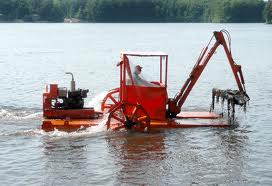 For those of you who attended the Fall Membership Meeting of the SHLPOA, you know that there were intensive discussions with respect to Hydroraking the North End of Seven Hills Lake, in order to rescue the lake for recreational purposes. Hydroraking is not cheap, and that fact has put the board and its members in a somewhat precarious position. The inlet from White Pond Reservoir is being strangled and will eventually be sealed off, with no water flow into the lake. With the spread of the indiginous water lilies has come an abundance of silt and sediment which have turned much of the North End into muck. This muck, has also made the north end of the lake very shallow and is threatening to take the lake back to its origins as a swamp. There is more information about hydroraking from Allied Biological here, with photos of the process here. Be sure and attend the Spring Membership meeting - for an update with respect to this issue - and review the site for even more information about what nature is doing to cause this unfortunate situation.
For those of you who attended the Fall Membership Meeting of the SHLPOA, you know that there were intensive discussions with respect to Hydroraking the North End of Seven Hills Lake, in order to rescue the lake for recreational purposes. Hydroraking is not cheap, and that fact has put the board and its members in a somewhat precarious position. The inlet from White Pond Reservoir is being strangled and will eventually be sealed off, with no water flow into the lake. With the spread of the indiginous water lilies has come an abundance of silt and sediment which have turned much of the North End into muck. This muck, has also made the north end of the lake very shallow and is threatening to take the lake back to its origins as a swamp. There is more information about hydroraking from Allied Biological here, with photos of the process here. Be sure and attend the Spring Membership meeting - for an update with respect to this issue - and review the site for even more information about what nature is doing to cause this unfortunate situation.
LAKE UPDATE FROM SPRING 2011 MEMBERSHIP MEETING
 This subject matter was covered in detail at the Spring Board Meeting, but for those of you who may have missed it, the New York State Department of Environmental Conservation has changed the permitting rules about weeds and plant control for our lake this year. Permits that we were routinely granted for chemical application for weed control have been denied as incomplete. NYS completely changed their watershed description and we are now required to spend upwards of $15,000 for various studies to become eligible for a permit. We have begun the testing and other studies that are required by this new NYS ruling however it is unlikely that we will be able to get a permit for weed control for 2009. And even if we are able to get a permit for this year we will not have the money due to the onerous cost of the new studies required. The lily pads will not be allowed to be removed by chemicals from the lake as they are indigenous to the area. The other weeds that we have been treating for are still eligible to be removed as they are “invasive” species. Repair work is being done on the weed harvester so that will be running soon to try and help the weed problem.
This subject matter was covered in detail at the Spring Board Meeting, but for those of you who may have missed it, the New York State Department of Environmental Conservation has changed the permitting rules about weeds and plant control for our lake this year. Permits that we were routinely granted for chemical application for weed control have been denied as incomplete. NYS completely changed their watershed description and we are now required to spend upwards of $15,000 for various studies to become eligible for a permit. We have begun the testing and other studies that are required by this new NYS ruling however it is unlikely that we will be able to get a permit for weed control for 2009. And even if we are able to get a permit for this year we will not have the money due to the onerous cost of the new studies required. The lily pads will not be allowed to be removed by chemicals from the lake as they are indigenous to the area. The other weeds that we have been treating for are still eligible to be removed as they are “invasive” species. Repair work is being done on the weed harvester so that will be running soon to try and help the weed problem.
FIRST DRAFT - AQUATIC MANAGMENT PLAN FROM DR. FIELDS
Click HERE to see the draft of the proposed SHL Plan from Dr. Fields
A Note From Dr. Fields:
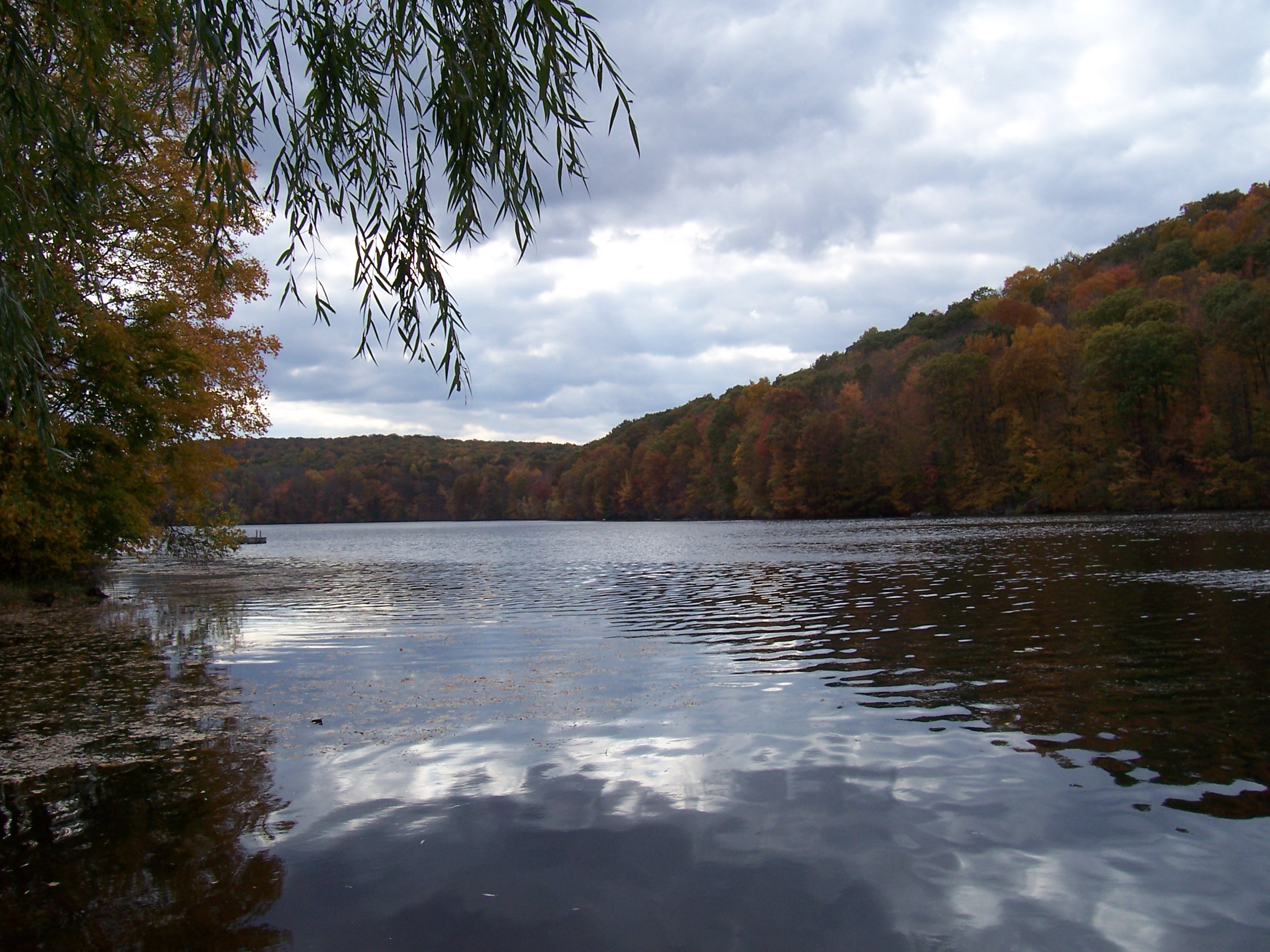 Attached is the text of the draft Plan. I have also attached a pdf file containing information on aquatic plant management plans from the DEC website. At the end of the file Appendix 1 outlines the elements of a plan; this will help you understand the way my document is structured. I began my plan with a description of the physical setting, which I think is critical background to understanding what was being proposed, then followed the outline of the appendix. In general, permits are not required for benthic barrier outside the Adirondack Park. In some DEC Regions, however, I understand that wetlands permits are required if barriers are used in wetlands viewed by DEC as important, or where the entire lake is a wetland or surrounded by a wetland. This could be the case at Seven Hills Lake. As we progress through this permitting process, it will become clearer whether individual landowners will be required to obtain permits at Seven Hills Lake. I want to include in the plan some mention of any methods that the Assn and individual landowners might want to use, and delineate whose responsibility it will be to obtain any permits that might be required, so let me know of any technique that you think might be practical to use. I have attached another pdf file from DEC discussing various local control methods for aquatic plants that will give you some background in what DEC views as practical.
Attached is the text of the draft Plan. I have also attached a pdf file containing information on aquatic plant management plans from the DEC website. At the end of the file Appendix 1 outlines the elements of a plan; this will help you understand the way my document is structured. I began my plan with a description of the physical setting, which I think is critical background to understanding what was being proposed, then followed the outline of the appendix. In general, permits are not required for benthic barrier outside the Adirondack Park. In some DEC Regions, however, I understand that wetlands permits are required if barriers are used in wetlands viewed by DEC as important, or where the entire lake is a wetland or surrounded by a wetland. This could be the case at Seven Hills Lake. As we progress through this permitting process, it will become clearer whether individual landowners will be required to obtain permits at Seven Hills Lake. I want to include in the plan some mention of any methods that the Assn and individual landowners might want to use, and delineate whose responsibility it will be to obtain any permits that might be required, so let me know of any technique that you think might be practical to use. I have attached another pdf file from DEC discussing various local control methods for aquatic plants that will give you some background in what DEC views as practical.
PROOF THAT SEVEN HILLS LAKE IS CLEAN
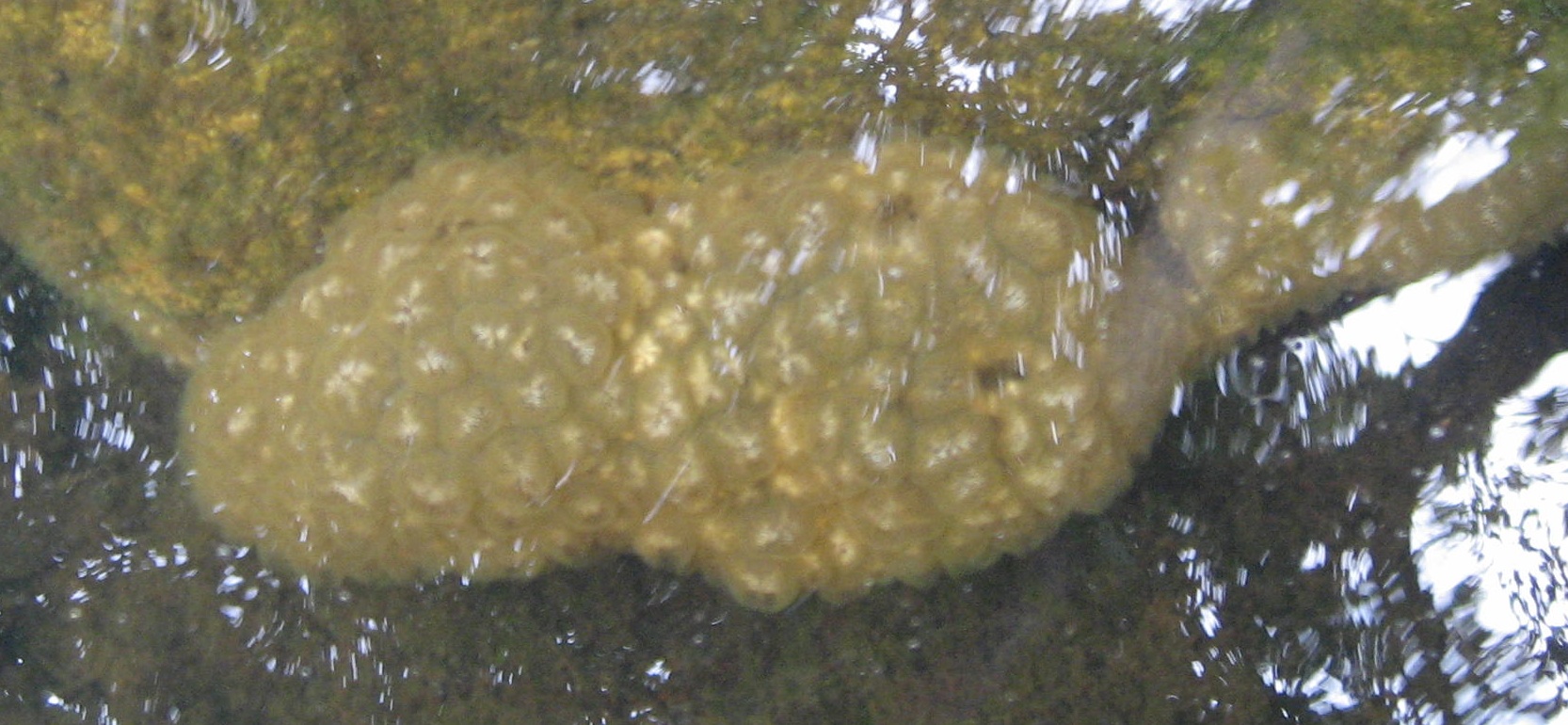
One of our lake association members submitted this photo with the comment: "There is a strange thing growing on a rock in the water at my property. It's shaped like a big amoeba and is tan with spots on it. When I pushed on it with a pole, it depressed and seems to be soft and spongey. Do you know anything about this? If not, who can I talk to? It would be good if someone would look at this." The answer from our lake consultant, Dr. Thomas Fields, Phd. was encouraging to say the least: "Your photos are of a huge colony of bryozoans or moss animalcules. This species, Pectinatella magnifica, forms huge gelatinous shapes around twigs, ropes, and ductwork in freshwater lakes, ponds, and reservoirs. The mass is a colony of many thousands smaller animals that filter algae and other smaller animals out of the water. They can't survive in polluted water so wherever you took the photos is a non-polluted body of water. They are completely harmless and generally will exist right through fall as the large mass you photographed. There are only a handful of bryozoans species found in freshwater with many more species found in our oceans. Sort of like many more sponges in salt water than freshwater. I've seen then many times mainly at places like the Ashokan Reservoir, Big Pond and many of the Adirondack lakes."
DIDYMO ALERT
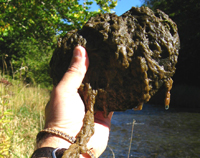 We received a disturbing communication from our resident Lake Expert, Jim Polk. It seems we are under siege in our region to the threat of Didymo. Didymo (Didymosphenia geminata), also known as "rock snot," is a non-native invasive microscopic algae (diatom) that can produce large amounts of stalk material to form thick brown mats on stream bottoms. Didymo threatens aquatic habitat, biodiversity and recreational opportunities. Native to northern North America and Europe, didymo has rapidly expanded its range, invading streams in several western states before moving east. Didymo has been found in several major New York water-based recreational rivers. Historically, didymo has been found in cool, clear, nutrient poor waters but has expanded its worldwide distribution to include nutrient rich waters. Rivers with stable, regulated flows are particularly at risk. The first thing that popped into Jim's mind as he found out more about this threat is that: NO BOATS THAT TRAVEL TO OTHER LAKES CAN BE ALLOWED IN OUR LAKE - PERIOD! We have that rule in place, but as we all can attest it is rarely enforced. If you want to put a boat in our lake keep it there. There is a video from New Zealand and more information here. Didymo travels on boats, fishing tackle, just about anything. Just a few drops of it can infect an entire body of water. People that fish in our lake as well as other lakes should keep seperate rods and tackle so that they do not carry potentially dangerous infected water back to us. This may sound extreme, but we need to protect our lake. The DEC's take on this problem is linked here.
We received a disturbing communication from our resident Lake Expert, Jim Polk. It seems we are under siege in our region to the threat of Didymo. Didymo (Didymosphenia geminata), also known as "rock snot," is a non-native invasive microscopic algae (diatom) that can produce large amounts of stalk material to form thick brown mats on stream bottoms. Didymo threatens aquatic habitat, biodiversity and recreational opportunities. Native to northern North America and Europe, didymo has rapidly expanded its range, invading streams in several western states before moving east. Didymo has been found in several major New York water-based recreational rivers. Historically, didymo has been found in cool, clear, nutrient poor waters but has expanded its worldwide distribution to include nutrient rich waters. Rivers with stable, regulated flows are particularly at risk. The first thing that popped into Jim's mind as he found out more about this threat is that: NO BOATS THAT TRAVEL TO OTHER LAKES CAN BE ALLOWED IN OUR LAKE - PERIOD! We have that rule in place, but as we all can attest it is rarely enforced. If you want to put a boat in our lake keep it there. There is a video from New Zealand and more information here. Didymo travels on boats, fishing tackle, just about anything. Just a few drops of it can infect an entire body of water. People that fish in our lake as well as other lakes should keep seperate rods and tackle so that they do not carry potentially dangerous infected water back to us. This may sound extreme, but we need to protect our lake. The DEC's take on this problem is linked here.
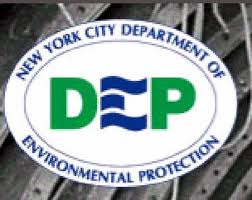 We realize that not everyone is on the email list of the New York City Department of Environmental Protection, so we figured it might be a good idea to post the January 2011 newsletter here. It is a newsletter for those who enjoy the recreational use of the land and waters of the New York City water supply. Check it out, it has a lot of useful information.
We realize that not everyone is on the email list of the New York City Department of Environmental Protection, so we figured it might be a good idea to post the January 2011 newsletter here. It is a newsletter for those who enjoy the recreational use of the land and waters of the New York City water supply. Check it out, it has a lot of useful information.
NEWS ABOUT THE LAKES IN OUR REGION
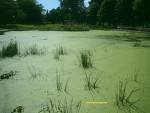 Not sure if anyone else has been following the story of neighboring Peach Lake over the course of the past few years, or if any of you saw the local articles in the newspapers this week. Initial funding has now been received to begin the rescue process of Peach Lake. At Peach Lake, which is part of the New York City Watershed, the septic runoff grew so significant and toxic that is literally polluted the lake and ruined it for recreational pursuits. Now, thanks to concerned citizens, the Peach Lake Coalition and the action of local, regional, state and federal politicians, the Town of Southeast has been granted $1.9 million and the Town of North Salen has been granted $5 million to get the $24 million dollar project started. There is some interesting commentary here from 2005 and the recent article from the Journal News appears below. The article from June of this year, announcing the $13 million dollars in New York State recovery funds is here.
Not sure if anyone else has been following the story of neighboring Peach Lake over the course of the past few years, or if any of you saw the local articles in the newspapers this week. Initial funding has now been received to begin the rescue process of Peach Lake. At Peach Lake, which is part of the New York City Watershed, the septic runoff grew so significant and toxic that is literally polluted the lake and ruined it for recreational pursuits. Now, thanks to concerned citizens, the Peach Lake Coalition and the action of local, regional, state and federal politicians, the Town of Southeast has been granted $1.9 million and the Town of North Salen has been granted $5 million to get the $24 million dollar project started. There is some interesting commentary here from 2005 and the recent article from the Journal News appears below. The article from June of this year, announcing the $13 million dollars in New York State recovery funds is here.
PRAISING PROGRESS AT PEACH LAKE
BY MICHAEL RISINIT - THE JOURNAL NEWS • MRISINIT@LOHUD.COM • NOVEMBER 22, 2009
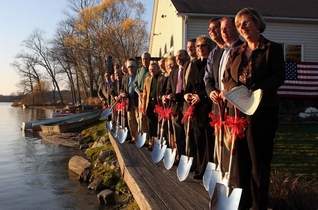
Those involved in preserving Peach Lake were given shovels during the groundbreaking for the long-awaited sewer system Saturday at Vails Grove in Peach Lake. (Tania Savayan/The Journal News)
NORTH SALEM — Tom Duffy, chairman of the Peach Lake Coalition, stood on the porch of the Vails Grove Pavilion at the lake and gave a two-minute summary of the almost 40-year effort to rid the lake of pollution. His speech carried those who listened from 1971 to Saturday afternoon, from the initial effort to form a lake-improvement district to the receipt of almost $7 million in federal funds and the ceremonial groundbreaking to bring sewers to almost 500 homes. "The rest is history that is being written at this very moment," Duffy said Saturday. About 150 residents, community leaders and elected officials came to the shores of Peach Lake to herald the major chunk of funding for the $24 million project and to mark the progress. The project will replace failing septic systems and keep sewage out of the lake that straddles the Westchester-Putnam border. Many of the homes were built as summer cottages on small lots and have failing or inadequate septic systems. Among those in attendence were Rep. John Hall, D-Dover Plains, who presented a $5 million check to North Salem and a $1.9 million check to Southeast. The amounts included federal stimulus money and other federal grants. Hall said the Peach Lake project, which is expected to create about 30 construction jobs, is why he voted for the American Recovery and Reinvestment Act. "This is exactly the kind of investment I hoped we could provide," Hall said. State Sen. Vincent Leibell, R-Patterson, said the lake's location in two counties and two towns always posed a challenge when it came to devising a solution to the pollution problem. He also had advice for the check recipients. "Both at home and in Washington, we have a lot of budget problems, so cash those checks right away," he joked. Organizers passed out silver shovels to officials and residents they felt deserved recognition for their part of the decades-long effort. Shovels were given to, among others, Southeast Supervisor Michael Rights, North Salem Supervisor Warren Lucas, Peggy Boyle, a member of the Peach Lake Coalition, and Paul Greenwood, the former North Salem supervisor who is facing fraud charges and is accused of taking $80 million from his trading companies' investors. Construction could start this year.
$2 MILLION PROBLEMS WITH OUR NEIGHBOR - LAKE OSCAWANA
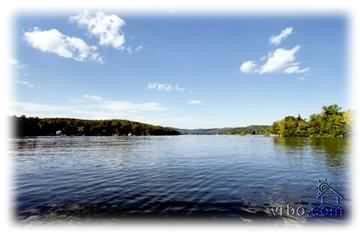
READ AND TAKE HEED
PHOSPHATES PLAN WOULD HELP LAKE OSCAWANA, STUDY SAYS
BY BARBARA LIVINGSTON NACKMAN JULY 20, 2009
COURTESY OF THE JOURNAL NEWS
PUTNAM VALLEY - Residents who hope to remove and keep phosphate out of Lake Oscawana are a bit closer to improving the water quality of the town's largest lake. The phosphate comes from stormwater runoff and septic systems, and the problem is complicated by rainy weather and lack of oxygen at the lake's bottom. This creates a mucky tangle of vegetation for swimmers and boaters. "We need to reverse the cycle of this nutrient pollution," said Stephen Axinn, the Lake Oscawana Civic Association president, who led a detailed study of the water body's condition. "We need to take steps to remove the phosphate and enact laws and regulations to prevent further sediment." The study calls for construction of catch basins with special cartridges to attract phosphate, and application of an aluminum compound to remove it. Further, the plan urges the town to enact laws requiring that septic systems be pumped out every three years and prohibiting the use of phosphate chemicals on lawns. The state Department of Environmental Conservation has declared the 386-acre natural lake an "impaired water body," which means it is safe for recreational use but has "water quality problems," DEC spokeswoman Wendy Rosenbach said. Lake Oscawana is well-known for its tree-lined landscape. Producers of the HBO series "The Sopranos" thought it looked like the Adirondacks and filmed episodes from its final season there. Past residents include baseball great Babe Ruth and "Jaws" actor Roy Scheider. Roughly 800 property owners have homes on the lake's shoreline or live in park districts with lake rights - Abele Park, Hilltop, Lookout Manor, Northview Estates and Wildwood Knolls. Lauren Carner of Abele Park said she hoped work on the lake began soon."It seemed so daunting when we started," she said of the study. "I hate to think of such a treasure impaired or damaged." Town Supervisor Robert Tendy said the lake pollution is not only an environmental issue, but could become a property-value issue. If the lake deteriorates, property values might fall, thereby reducing needed town revenue. County Legislator Vincent Tamagna, R-Philipstown, chairman of the Physical Services Committee, said legislators are discussing a countywide ban on the use of phosphates to protect the future of the waterways in Putnam's six towns. The remediation detailed in the Lake Oscawana Management Plan is estimated to cost $2 million and is designed to be enacted in four phases as funds become available. "It is essential we get outside funding. Otherwise many changes won't be possible," Tendy said. Axinn said he expected to apply for multiple grants to reduce the burden on lakeshore residents. The House of Representatives approved $400,000 this month as part of a fiscal 2010 Agriculture Appropriations Bill. The Senate and President Barack Obama must also approve the funding. In May, Rep. John Hall, D-Dover Plains, saw the lake's condition for himself. "The lake is in serious trouble and needs the cleanup help as soon as possible," he said.
LOCAL AND AREA NEWS
FIRE HYDRANT NOW INSTALLED AT SEVEN HILLS LAKE!
 As many of you know, the lake was drawn down at the dam recently so that a fire hydrant could be installed at Seven Hills Lake. Special thanks goes out to Howard Carpenter and the Kent Volunteer Fire Department for getting this done. The hydrant is located on the far right side of the beach area, as you are looking at the beach from Seven Hills Lake Drive.
As many of you know, the lake was drawn down at the dam recently so that a fire hydrant could be installed at Seven Hills Lake. Special thanks goes out to Howard Carpenter and the Kent Volunteer Fire Department for getting this done. The hydrant is located on the far right side of the beach area, as you are looking at the beach from Seven Hills Lake Drive.
A HOME GROWN DEER REPELLANT RECIPE
 If you are like most of us, you are probably finding that the hungry deer are eating everything in sight, including those precious plants and flowers you have so carefully cultivated and nourished since early spring. A local resident, Evelyn Schunk, has given us a recipe which she has found helpful to use as a deer repellant. The recipe is one egg, 1/2 cup milk, 1 tablespoon vegetable oil and one tablespoon dish detergent all mixed in a gallon of water. Place the mixture in a spray bottle and keep the plants you wish to protect covered liberally with the mixture. Remember that rain water washes the mixture off, so you should reapply after the rain. Let us know how you do with this and let us know if you have any other suggestions on this topic.
If you are like most of us, you are probably finding that the hungry deer are eating everything in sight, including those precious plants and flowers you have so carefully cultivated and nourished since early spring. A local resident, Evelyn Schunk, has given us a recipe which she has found helpful to use as a deer repellant. The recipe is one egg, 1/2 cup milk, 1 tablespoon vegetable oil and one tablespoon dish detergent all mixed in a gallon of water. Place the mixture in a spray bottle and keep the plants you wish to protect covered liberally with the mixture. Remember that rain water washes the mixture off, so you should reapply after the rain. Let us know how you do with this and let us know if you have any other suggestions on this topic.
CHRIS BELLESHEIM WINS HOLY SMOKE HOME BREWERS CHALLENGE!
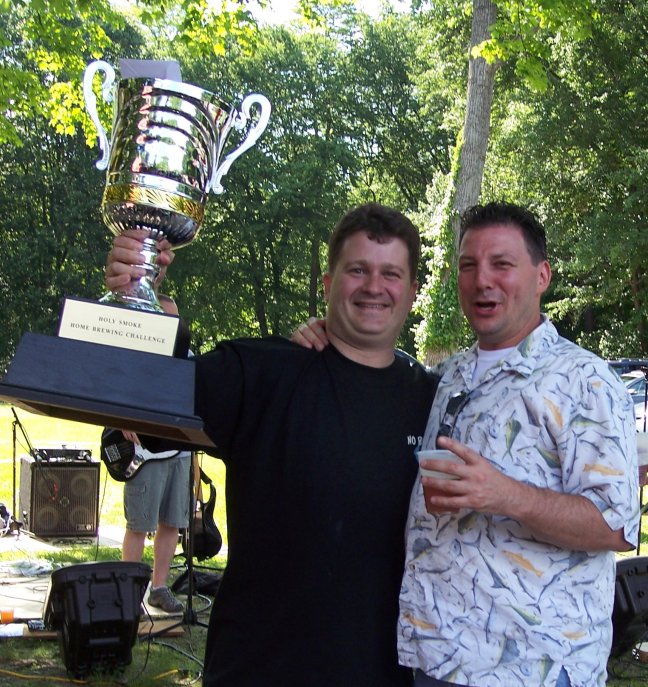
 You would probably have to be either living under a rock - or else not attending the fabulous Seven Hills Lake Association parties - to not realize that some of the best brewers in the tri-state area seem to be living near our shorelines. Now we have solid proof. Local home brewer Chris Bellesheim won the Home Brewer's Challenge at the Holy Smoke restaurant! Three styles were open for judging - American or English Pale Ale, American or German Pilsner or American or German Weissbier. The judging was conducted by noted brewmasters from Captain Lawrence, Blue Point and Three Floyds. Chris now has his name engraved on the Holy Smoke Chalice trophy along with a gift certificate. A hearty congratulations goes out to Chris!
You would probably have to be either living under a rock - or else not attending the fabulous Seven Hills Lake Association parties - to not realize that some of the best brewers in the tri-state area seem to be living near our shorelines. Now we have solid proof. Local home brewer Chris Bellesheim won the Home Brewer's Challenge at the Holy Smoke restaurant! Three styles were open for judging - American or English Pale Ale, American or German Pilsner or American or German Weissbier. The judging was conducted by noted brewmasters from Captain Lawrence, Blue Point and Three Floyds. Chris now has his name engraved on the Holy Smoke Chalice trophy along with a gift certificate. A hearty congratulations goes out to Chris!
THE CONTROVERSIAL CORMORANTS HAVE INVADED OUR AREA
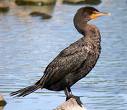 A scene vaguley remisicent of Alfred Hitchcock's "The Birds" has landed near our shores. If you look closely on Route 301 overlooking the West Branch Reservoir - in a very large dead tree near the Carmel-Kent Lakes border - you will see a colony of cormorants. These controversial birds are members of the pelican family and many fishermen see tham as direct competitors for the fish. These birds have the ability to dive from the surface and swim under water in order to catch and eat the fish. It's enough to make even the best fisherman a little jealous. It is for this very reason that this species has been hunted nearly to extinction in some areas, and thanks to convservation, it's numbers have now increased. In Norway the cormorant is considered a game bird with 10.000 taken annually for food. The birds range in size from 3 to 12 pounds and can have a wingspan from 48 to 63 inches. Many people consider a colony of cormorants gathering near your community to be a sign of extraordinary good luck. More than likely, the birds will be with us for the summer before migrating to the south.
A scene vaguley remisicent of Alfred Hitchcock's "The Birds" has landed near our shores. If you look closely on Route 301 overlooking the West Branch Reservoir - in a very large dead tree near the Carmel-Kent Lakes border - you will see a colony of cormorants. These controversial birds are members of the pelican family and many fishermen see tham as direct competitors for the fish. These birds have the ability to dive from the surface and swim under water in order to catch and eat the fish. It's enough to make even the best fisherman a little jealous. It is for this very reason that this species has been hunted nearly to extinction in some areas, and thanks to convservation, it's numbers have now increased. In Norway the cormorant is considered a game bird with 10.000 taken annually for food. The birds range in size from 3 to 12 pounds and can have a wingspan from 48 to 63 inches. Many people consider a colony of cormorants gathering near your community to be a sign of extraordinary good luck. More than likely, the birds will be with us for the summer before migrating to the south.
WESTCHESTER LAWMAKERS TO LIMIT FERTILIZERS ON LAWNS
 The Journal News is reporting that Westchester County is taking dramatic steps to limit the usage of fertilizers on lawns in an effort to limit the algae blooms in our lakes and reservoirs and to protect the drinking water. Fertilizers are full of phospherous and cause untold damage upon our water supplies. Certainly, Putnam County should be enacting similar or even stricter legislation than our neighbors to the south. The full text of the article is here. It all boils down to one simple fact: If you truly care about the lakes, rivers, streams, ponds and ultimately our reservoirs - and even the wells that provide OUR drinking water - you will STOP using fertilizers on your lawn.
The Journal News is reporting that Westchester County is taking dramatic steps to limit the usage of fertilizers on lawns in an effort to limit the algae blooms in our lakes and reservoirs and to protect the drinking water. Fertilizers are full of phospherous and cause untold damage upon our water supplies. Certainly, Putnam County should be enacting similar or even stricter legislation than our neighbors to the south. The full text of the article is here. It all boils down to one simple fact: If you truly care about the lakes, rivers, streams, ponds and ultimately our reservoirs - and even the wells that provide OUR drinking water - you will STOP using fertilizers on your lawn.
MUTE SWANS MAKE A SPRING APPEARANCE ON SEVEN HILLS LAKE!
 Two mute swans have been spotted by residents on the lake intermittently mid-march and we are all hoping they decide to make this their nesting home. After the loss of Papa Swan last season, we need to have a small replacement family of swans on the lake. A small family of swans is good for the habitat, while an overpopulation can have a negative impact on native wildlife. There is some information on Mute Swans here written by local resident George Baum which was published in 1998 and is reprinted here.
Two mute swans have been spotted by residents on the lake intermittently mid-march and we are all hoping they decide to make this their nesting home. After the loss of Papa Swan last season, we need to have a small replacement family of swans on the lake. A small family of swans is good for the habitat, while an overpopulation can have a negative impact on native wildlife. There is some information on Mute Swans here written by local resident George Baum which was published in 1998 and is reprinted here.
INVASIVE PLANT AWARENESS SIGNS
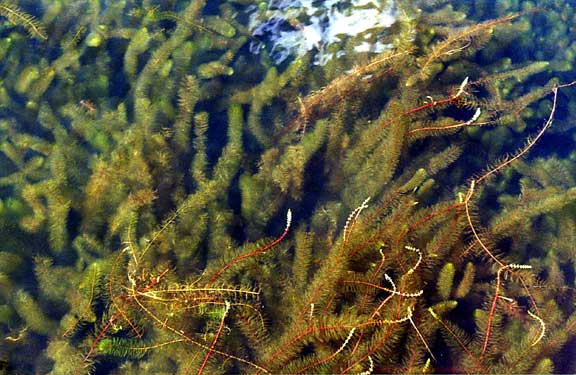 Allied Biological is now offering Invasive Plant Awareness Signs. These signs are designed to be posted at boat access points to improve public awareness of invasive aquatic plants. Please see the attached file for details here. For more information or to place an order for the signs, please contact Krista Michniewicz, the Lake Services Specialist at Allied Biological Inc., 580 Rockport Road, Hackettstown, NJ 07840. The telephone number is 908-850-0303.
Allied Biological is now offering Invasive Plant Awareness Signs. These signs are designed to be posted at boat access points to improve public awareness of invasive aquatic plants. Please see the attached file for details here. For more information or to place an order for the signs, please contact Krista Michniewicz, the Lake Services Specialist at Allied Biological Inc., 580 Rockport Road, Hackettstown, NJ 07840. The telephone number is 908-850-0303.
THREE VERSIONS: DRAMATIC SEVEN HILLS LAKE RESCUE
Tom and Tommy O'Connor Jr., a local father and son team, were true local heroes who, along with Richard Allen, literally saved the life of a drowning man in November of 2007. The man was a weekend resident of Seven Hills Lake and New York City attorney Marc Rapaport. Quick thinking and Tom's razor sharp instincts - developed from his military training - saved the day. Congratulations to all concerned and thanks to the Journal News and the Mid-Hudson News for the following stories from December 14-15, 2008; and to Eyewitness News for the third story which is reprinted from October 26, 2008:
TWO KENT CLIFFS MEN RECEIVE NATIONAL AWARD FOR LAKE RESCUE
Mid-Hudson News Network, December 15, 2008
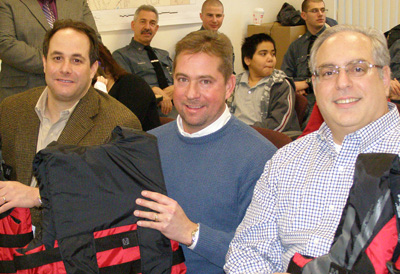
Rapaport, left, with O'Connor, center, and Allen
TOWN OF KENT - Marc Rapaport will be celebrating the holidays again this year thanks to the heroics of two neighbors. Rapaport, 41, a New York City attorney, residing in a remote section of western Kent was checking on his rare Indian Runner ducks at Seven Hills Lake, the weekend after Thanksgiving 2007, when his canoe capsized tossing the man into the frigid water. Rapaport recalled Sunday at Kent Police Department headquarters where 100 people gathered to recognize the two men who saved his life, “Seconds after I hit the water, I knew this was a very bad situation. I was absolutely freezing and I could no longer move. It was that cold!” Hypothermia set in and since Rapaport suffers from asthma, he began having difficulty breathing. Rapaport became immobilized and was losing consciousness. The time was getting late. Rapaport told the Putnam Courier. “My odds of survival were getting worse and worse by the second. My life flashed before me since I didn’t think I could survive much longer.” As Rapaport was knocking on death’s door his neighbors, Richard Allen and Thomas O’Connor noticed the boat in the middle of the lake and called out. “Is anyone out there? I heard funny noises coming from the darkened lake and called police,” said Allen. Within seconds O’Connor placed a boat in the water and took off into the darkness. Against the advice of emergency personnel who told him to stay put and wait for fire department personnel to arrive, the retired marine rowed out to the stricken Rapaport and pulled him out of the water. “I had to help him. He couldn’t have survived waiting for emergency responders to arrive.” Rapaport remembered drifting in and out of consciousness. “Tom’s military background was never more evident since he began barking out orders, ‘Say something! What’s your name? How old are you? Where are you?’ Tom knew I was in bad shape and he didn’t want me to fall asleep and never wake up.” Rapaport told the ceremony that he was in “complete and total awe” of the people who saved his life. “This experience changed my life forever. I owe these men my life.” Both Allen and O’Connor were presented with America’s first Award of Commendation from the National Association of State Boating Law Administrators and New York State’s initial Life Saving Award from the state Office of Parks and Recreation.
TWO HONORED FOR SEVEN HILLS LAKE RESCUE
By Ernie Garcia, The Journal News • December 14, 2008
 KENT - Police, state parks officials and the U.S. Coast Guard recognized two Seven Hills Lake men yesterday for rescuing a canoeist from freezing water last year. Thomas O'Connor, 42, and Richard Allen, 56, received a commendation award from the National Association of State Boating Law Administrators, and a Life Saving Award from the New York State Office of Parks, Recreation and Historic Preservation for their rescue of Marc Rapaport, 41, on November 25, 2007. Rapaport's canoe turned over in choppy water, and he was not wearing a life jacket. He was unable to swim to the shore because the cold water numbed his limbs, so all he could do was hold on to a floating branch. "I would truly not be here if not for them," said Rapaport, an attorney who lives in New York City and visits his Seven Hills Lake home on weekends, during yesterday's ceremony. O'Connor, a superintendent with Metro-North Railroad, and Allen, an employee benefits manager, credit the other for saving Rapaport. "Rich saw the canoe and he knew something was wrong," O'Connor said of the empty canoe floating in the middle of the lake. Allen said he called out to the lake when he saw the empty canoe and then heard what he described as a guttural noise return from the water. Allen then alerted O'Connor, who got in his boat and rowed into the middle of the lake, where he found Rapaport about 25 to 50 feet from the canoe. "I knew the Police Department would not come in time," said Allen, praising O'Connor's military survival training. "(Rapaport) was saved by God and the U.S. Marines. (O'Connor) knew when we pulled him out of the water that we had to pull off his clothes." Canoe and kayak accidents accounted for 40 percent of boating fatalities in the northeast last year, said Alfred Johnson of the Coast Guard's Recreational Boating Safety department. Johnson, who attended yesterday's ceremony, said that even if Rapaport had been wearing a life jacket, it might not have saved him from hypothermia if his neighbors hadn't found him. Johnson noted that about 80 percent of boating fatalities occur as a result of capsizing or falling overboard, and in almost 90 percent of those cases the individuals are not wearing life jackets. After the awards ceremony, Rapaport said that the actions of his neighbors - whom he did not know well before the rescue - have changed his life and made him more attentive to helping others. For instance, he tracked down the owner of a lost briefcase to return it. "I try to live up to what they did," Rapaport said.
KENT - Police, state parks officials and the U.S. Coast Guard recognized two Seven Hills Lake men yesterday for rescuing a canoeist from freezing water last year. Thomas O'Connor, 42, and Richard Allen, 56, received a commendation award from the National Association of State Boating Law Administrators, and a Life Saving Award from the New York State Office of Parks, Recreation and Historic Preservation for their rescue of Marc Rapaport, 41, on November 25, 2007. Rapaport's canoe turned over in choppy water, and he was not wearing a life jacket. He was unable to swim to the shore because the cold water numbed his limbs, so all he could do was hold on to a floating branch. "I would truly not be here if not for them," said Rapaport, an attorney who lives in New York City and visits his Seven Hills Lake home on weekends, during yesterday's ceremony. O'Connor, a superintendent with Metro-North Railroad, and Allen, an employee benefits manager, credit the other for saving Rapaport. "Rich saw the canoe and he knew something was wrong," O'Connor said of the empty canoe floating in the middle of the lake. Allen said he called out to the lake when he saw the empty canoe and then heard what he described as a guttural noise return from the water. Allen then alerted O'Connor, who got in his boat and rowed into the middle of the lake, where he found Rapaport about 25 to 50 feet from the canoe. "I knew the Police Department would not come in time," said Allen, praising O'Connor's military survival training. "(Rapaport) was saved by God and the U.S. Marines. (O'Connor) knew when we pulled him out of the water that we had to pull off his clothes." Canoe and kayak accidents accounted for 40 percent of boating fatalities in the northeast last year, said Alfred Johnson of the Coast Guard's Recreational Boating Safety department. Johnson, who attended yesterday's ceremony, said that even if Rapaport had been wearing a life jacket, it might not have saved him from hypothermia if his neighbors hadn't found him. Johnson noted that about 80 percent of boating fatalities occur as a result of capsizing or falling overboard, and in almost 90 percent of those cases the individuals are not wearing life jackets. After the awards ceremony, Rapaport said that the actions of his neighbors - whom he did not know well before the rescue - have changed his life and made him more attentive to helping others. For instance, he tracked down the owner of a lost briefcase to return it. "I try to live up to what they did," Rapaport said.
HOMETOWN HEROES
Eyewitness News, October 26, 2008

 New York (WABC) -- Being a Hometown Hero runs in the blood of the O'Connor family. Hometown Hero Tommy O'Connor, Jr., deserves recognition as a Hometown Hero for helping to save a man's life when he was only 11 years old. On November 25, 2007, because of Tommy's bravery and quick thinking, Tommy's father, Tom O'Connor, was able to rescue a man who was struggling to stay afloat in the frigid waters of the lake near Tommy's house. Tommy's father, Tom O'Connor, a former Marine who served in the Gulf War, was able to pull this near lifeless man out of the icy waters of Seven Hills Lake in Kent, NY. The victim had capsized in his canoe and was treading in the chilly water for nearly an hour when he became incapacitated from asthma and hypothermia. After his son notified him as to the dangerous situation, Tom quickly pulled the man from the water into his row boat and took him to shore where paramedics successfully performed life-saving actions. Due to the O'Connors' bravery and selfless actions, the victim, a Manhattan Lawyer, is alive today!
New York (WABC) -- Being a Hometown Hero runs in the blood of the O'Connor family. Hometown Hero Tommy O'Connor, Jr., deserves recognition as a Hometown Hero for helping to save a man's life when he was only 11 years old. On November 25, 2007, because of Tommy's bravery and quick thinking, Tommy's father, Tom O'Connor, was able to rescue a man who was struggling to stay afloat in the frigid waters of the lake near Tommy's house. Tommy's father, Tom O'Connor, a former Marine who served in the Gulf War, was able to pull this near lifeless man out of the icy waters of Seven Hills Lake in Kent, NY. The victim had capsized in his canoe and was treading in the chilly water for nearly an hour when he became incapacitated from asthma and hypothermia. After his son notified him as to the dangerous situation, Tom quickly pulled the man from the water into his row boat and took him to shore where paramedics successfully performed life-saving actions. Due to the O'Connors' bravery and selfless actions, the victim, a Manhattan Lawyer, is alive today!
THE RESCUE OF "PAPA" SWAN TURNS BITTERSWEET
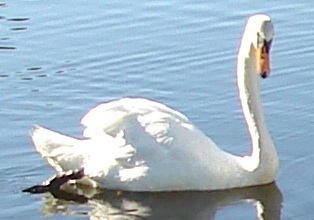 For those of you who may not have seen or heard about it, there was a dramatic swan rescue on our lake at the end of August. Although the swan only survived a few weeks after being treated and reintroduced into the lake, it was a noble effort on the part of all concerned. The Seven Hills Lake residents who took part in the rescue effort should be highly praised for their swift action and deep concern for the wildlife that resides on our lake. There are more photos of the release of Papa Swan back into the lake after his medical treatment here SwanReleasePhotos. He is survived by Mama Swan and her two children and was considered by many to be a patron Saint of the Lake. May he rest in peace. Below is the article from the Mid-Hudson News Network:
For those of you who may not have seen or heard about it, there was a dramatic swan rescue on our lake at the end of August. Although the swan only survived a few weeks after being treated and reintroduced into the lake, it was a noble effort on the part of all concerned. The Seven Hills Lake residents who took part in the rescue effort should be highly praised for their swift action and deep concern for the wildlife that resides on our lake. There are more photos of the release of Papa Swan back into the lake after his medical treatment here SwanReleasePhotos. He is survived by Mama Swan and her two children and was considered by many to be a patron Saint of the Lake. May he rest in peace. Below is the article from the Mid-Hudson News Network:
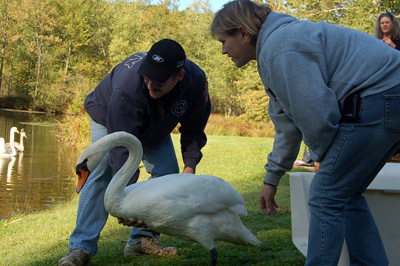
Joe and Lisa Acton make sure the swan is ready for water, while Leah Waybright Kennell looks on.
INJURED SWAN RELEASED BACK TO NATURE
KENT – After three weeks of tender love and care, an injured swan that was rescued from Seven Hills Lake in the Town of Kent, was released back to its natural environment this past weekend. “Lovie” or “Beauty Boy” as the bird was named by its rescuers, was pulled from the lake by members of the East Fishkill Fire District’s Cold Water Rescue Team on August 27. Two women had spotted four swans on the water with one acting out of the ordinary. The two hopped in a canoe, paddled over to the father swan, and notice some of its right leg was missing. After a few phone calls, EFFD volunteer Lisa Acton made an unusual call to her colleagues later that day “I came out, checked him out, and then realized I had to catch him. So I called the Cold Water Rescue team, and we came out here with a carrier and it took us about three and a half hours to catch him,” she said. “The neighbors came out with extra kayaks, and we surrounded him, threw him into one of the neighbor’s flat-bottom canoes, and rushed him to the vet’s.” Over the last three and a half weeks, Lisa and her husband Joe have been taking care of the swan, nicknamed “Beauty Boy” and “Lovie,” amongst other endearing names given by the two women, since its surgery at Somers Animal Hospital, which was provided free of charge. The veterinarian believes the swan was attacked by a snapping turtle, an accident that will cause “Beauty Boy” to have a limp for the rest of its life. This past Saturday, Lisa and Joe released the bird back into his natural environment. The maimed animal swam right over to its mate, which seemed to recognize him right away.
LOCAL NEWS ARTICLES ARCHIVE
For more news there is an archive of a few past local news articles here on the Articles page.
© Seven Hills Lake Property Owners Association, All Rights Reserved.

